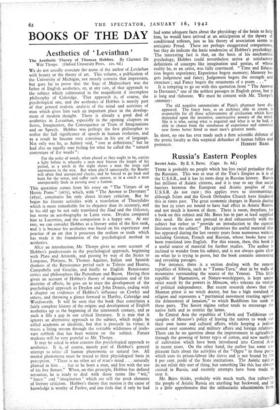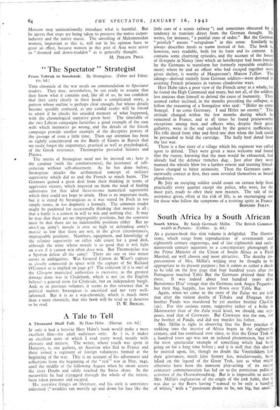Russia's Eastern Peoples
Soviet Asia. By E. S. Bates. (Cape. 8s. 6d.)
THERE is probably no people which has less racial prejudice than the Russians. This was as true of the Tsar's Empire as it is of the U.S.S.R., and it has its roots deep in Russian history. Russia has millions of Asiatic citizens, and it is true to say that social barriers between the European and Asiatic peoples of the U.S.S.R. do not exist; this applies even to intermarriage, although Islam and the Greek Orthodox Church have hindered this in times past. The great economic changes in Russia during the last 25 years are bound to have had effect in Asiatic Russia, and not much is known of them. There is room, therefore; for a book on this subject and Mr. Bates has in part at leas, supplied this need. He does not pretend to deal exhaustively with the subject but rather to "provide an introduction to the current literature on the subject." He epitomises the useful material that has appeared during the last twenty years from numerous writers, including German, French and Russian, whose books have not been translated into English. For this reason, then, this book is a useful source of material for further studies. The author is inclined to wander from his subject, and is not always quite cleat on what he is trying to prove, but the book contains interesting and revealing passages.
For instance, there is a section dealing with the remote republics of Siberia, such as " Tannu-Tuva," shut in by walls of mountains surrounding the source of the Yenesei. This little republic of Shamanists, or Nature-worshippers, is kept under strict watch by the powers in Moscow, who tolerate no vestige of' political independence. But recent research shows that the Shaman priest is no witch doctor, but has a high standard of religion and represents a "puritanical movement reacting against the debasement of lamaism," to which Buddhism has sunk in these parts. The Soviet regime rather tends to encourage the native faith and to restrict the lamas.
In Central Asia the republics of Uzbek and Tadjikistan are samples of Moscow's policy of leaving the natives to work out their own home and cultural affairs, while keeping a jealous control over economic and military affairs and foreign relations. There can .be no question about the improvement in agriculture through the growing of better types of cotton, and new methods of cultivation which have been introduced into Central A•ja in recent years. On the other hand, the author has some un- pleasant facts about the activities of the " Ogpu " in these parts, which uses its prison-labour like slaves and is not bound by the 8 per cent, profit of the State institutions. The Asiatic nath es do not relish this sort of thing, but something like this has always existea. in Russia, and recently attempts have been made to stop it.
Mr. Bates thinks, probably with much truth, that cultura!IY the people of Asiatic Russia are anything but backward, and he is a little apprehensive that the enthusiastic educationists freas
Moscow may unintentionally introduce what is harmful. But he agrees that steps are being taken to preserve the native carpet- industry and the native music. The unveiling of Mahommedan women, important as this is, will not in his opinion have so great an effect, because women in this part of Asia were never so "doomed and down-trodden" as is generally thought.
M. PHILIPS PRICE.



























 Previous page
Previous page